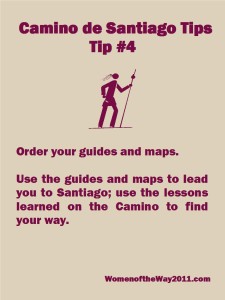 “We’re all pilgrims on the same journey – but some pilgrims have better road maps.” ~ Nelson DeMille
“We’re all pilgrims on the same journey – but some pilgrims have better road maps.” ~ Nelson DeMille
I started the Camino with the Pilgrim Guides to Spain: Camino Francés by the Confraternity of Saint James. Its goal is to “provide brief details of the route and of the sites of special historic or religious interest…that are found along the Way.” It includes sleeping, shopping, and dining suggestions, but it does not include a map. As a result, it was difficult to know where we were and whether to take a recommended side trip or continue forward.
In Lagroño, a Scottish pilgrim gave us the Michelin Camino de Santiago map. This booklet is strictly an elevation and road map. With the guides and maps, we felt more confident in our decisions about alternative routes and each day’s destination.
Even with the guide and maps, one needs to follow the waymarks. The more common ones are the yellow arrow and the scallop shell. For the most part, these are obvious, though at times, finding the arrow can be challenging. You need to look on buildings, on curbs (which may be blocked by a vehicle), on poles, or trees, everywhere. When you are unable to find the waymarking and there is no one to ask, trust the Camino and make a choice. The worst that can happen is that you will walk a little further that day. Perhaps by going astray, you will find yourself.
Many pilgrims walk with smartphones that are GPS enabled. There are several apps available for the Camino Francés. For more information, see the Camino de Santiago de Compostela forum discussion Download Camino to your GPS. The disadvantages of using only the GPS is not knowing what awaits you at the destination and what you are missing by not having a guidebook. At the moment, there is only one guidebook in ebook format, and this is for someone bicycling the Camino. Hopefully, more guidebooks will be released as an ebook, eliminating the extra weight of carrying a paperback. There are a few apps that might interest someone of the Camino Francés
Purchasing your guidebook helps plan the trip
For my upcoming Camino Portugués in 2013, I purchased John Brierley’s guide, which has detailed maps, cultural tidbits, and lodging and dining information. I am enjoying reading about what I will see on my journey and planning side trips. I did not do this on my first Camino and missed a lot, such as the Monastery in Samos. Ordering the guidebooks early also helps build the anticipation for the trip and helps you make informed decisions about time, daily schedules, and not-to-be-missed sites.
For your convenience, I am listing the following guides and maps sources.
- Amazon
- American Pilgrims on the Camino
- Confraternity of Saint James bookstore
- John Brierley’s Camino guides
Do you have favorite guides and maps? If so, comment below on why you like it.
Buen Camino,
Jane V. Blanchard
So far my favorite guide is “A Village to Village Guide to Walking the Camino” it is for the Camino Frances. I have/had a Brierley Guide but didn’t like the format and reading his directions was confusing. Perhaps they would have been less so if I was reading in situ.
Thanks for mentioning this guide and telling us why you liked it. I have it pinned to the Camino Books Pinterest Board